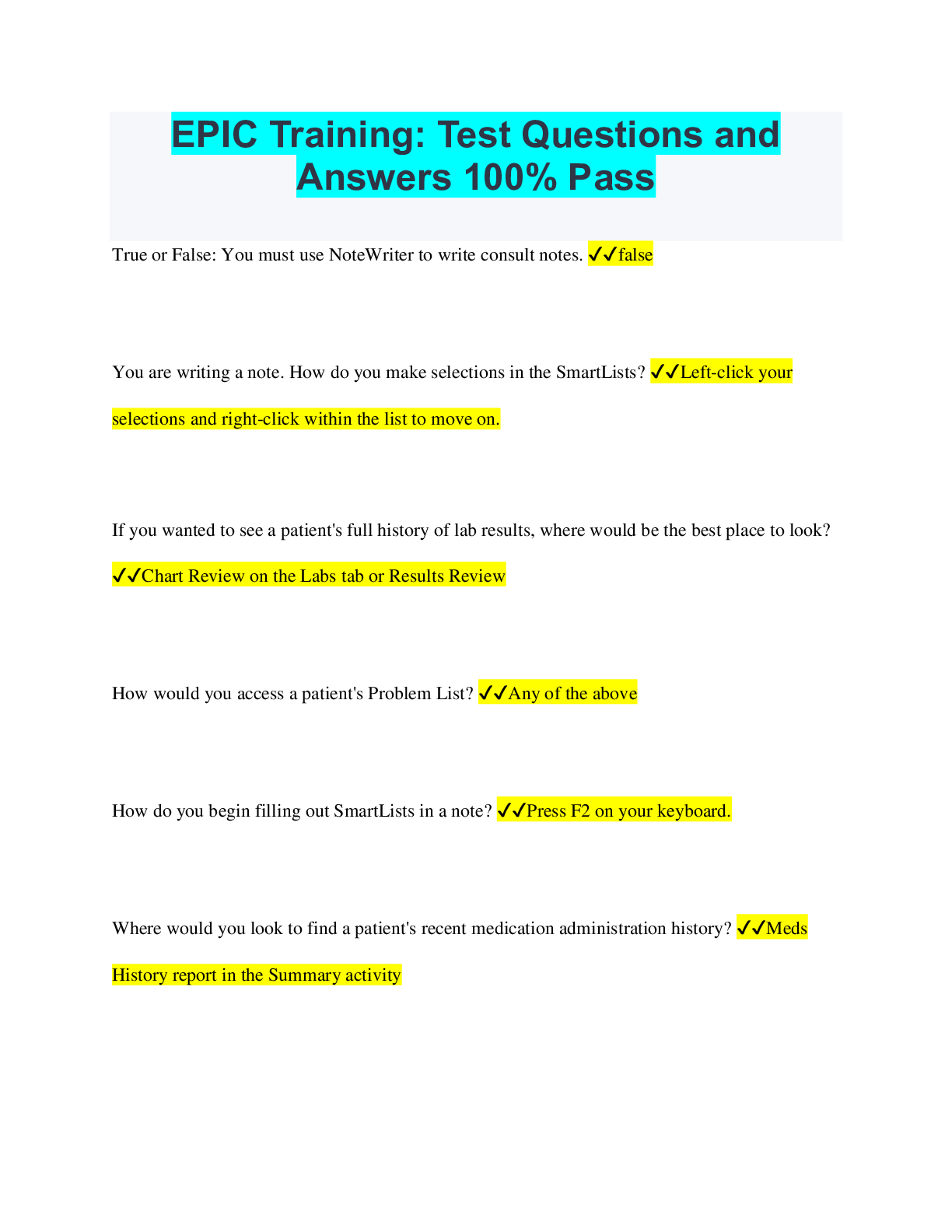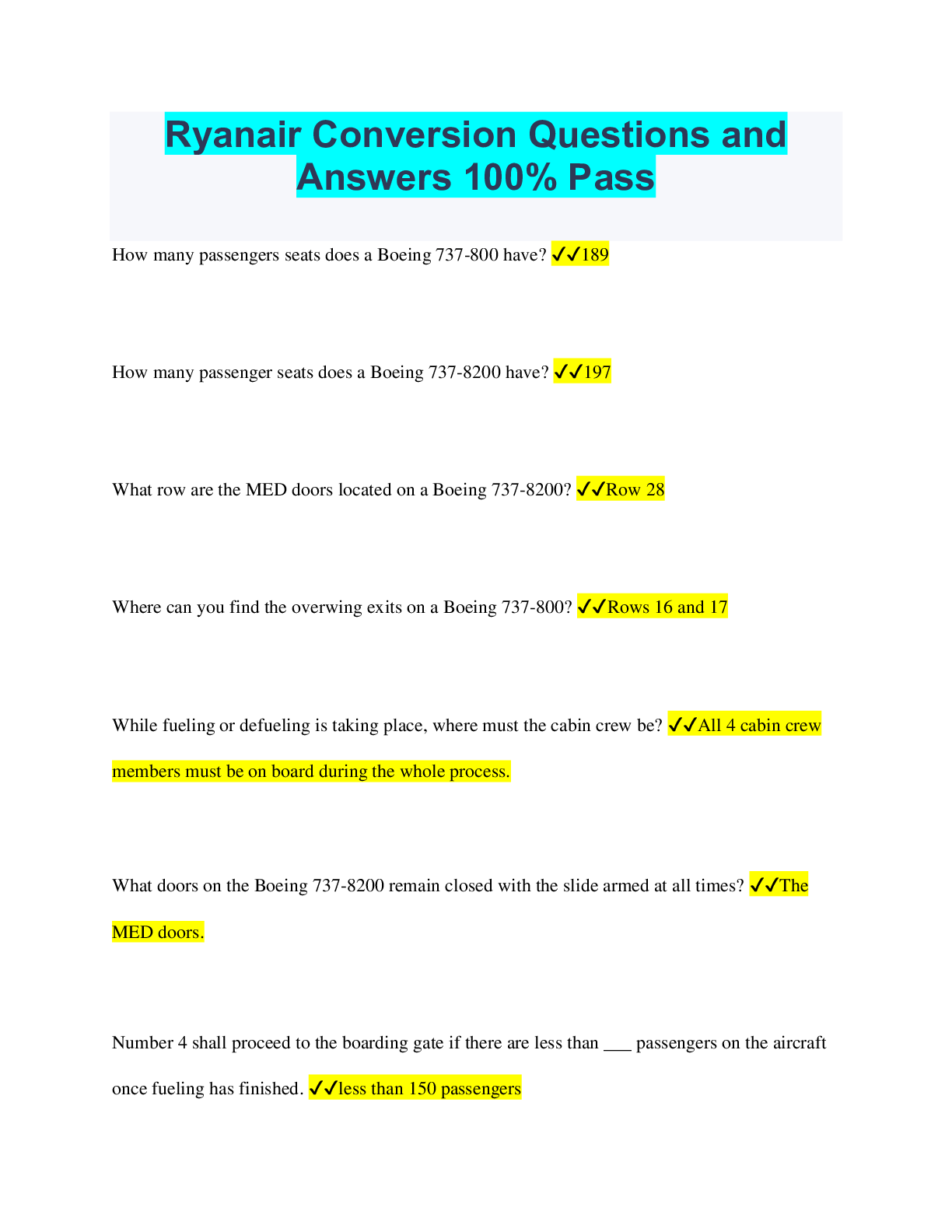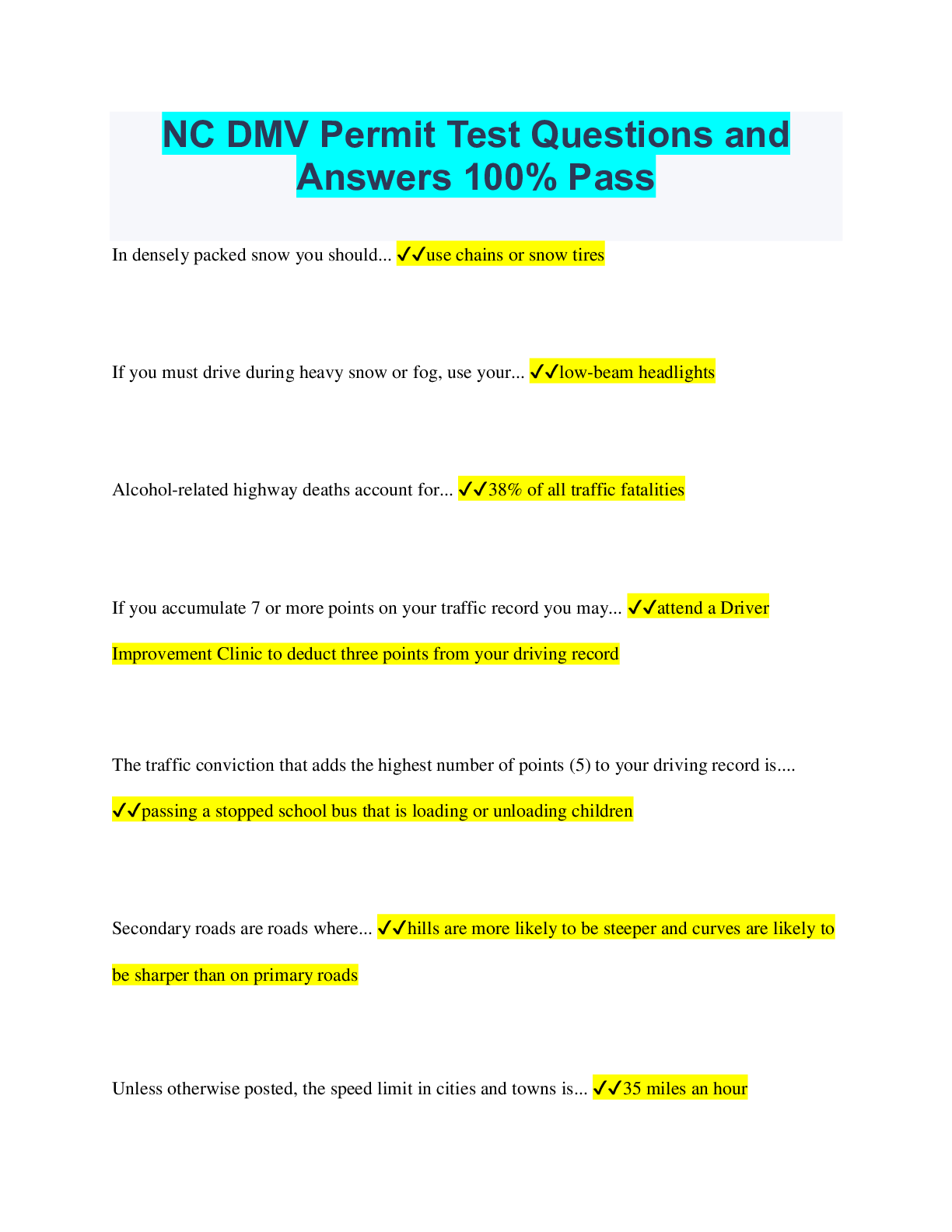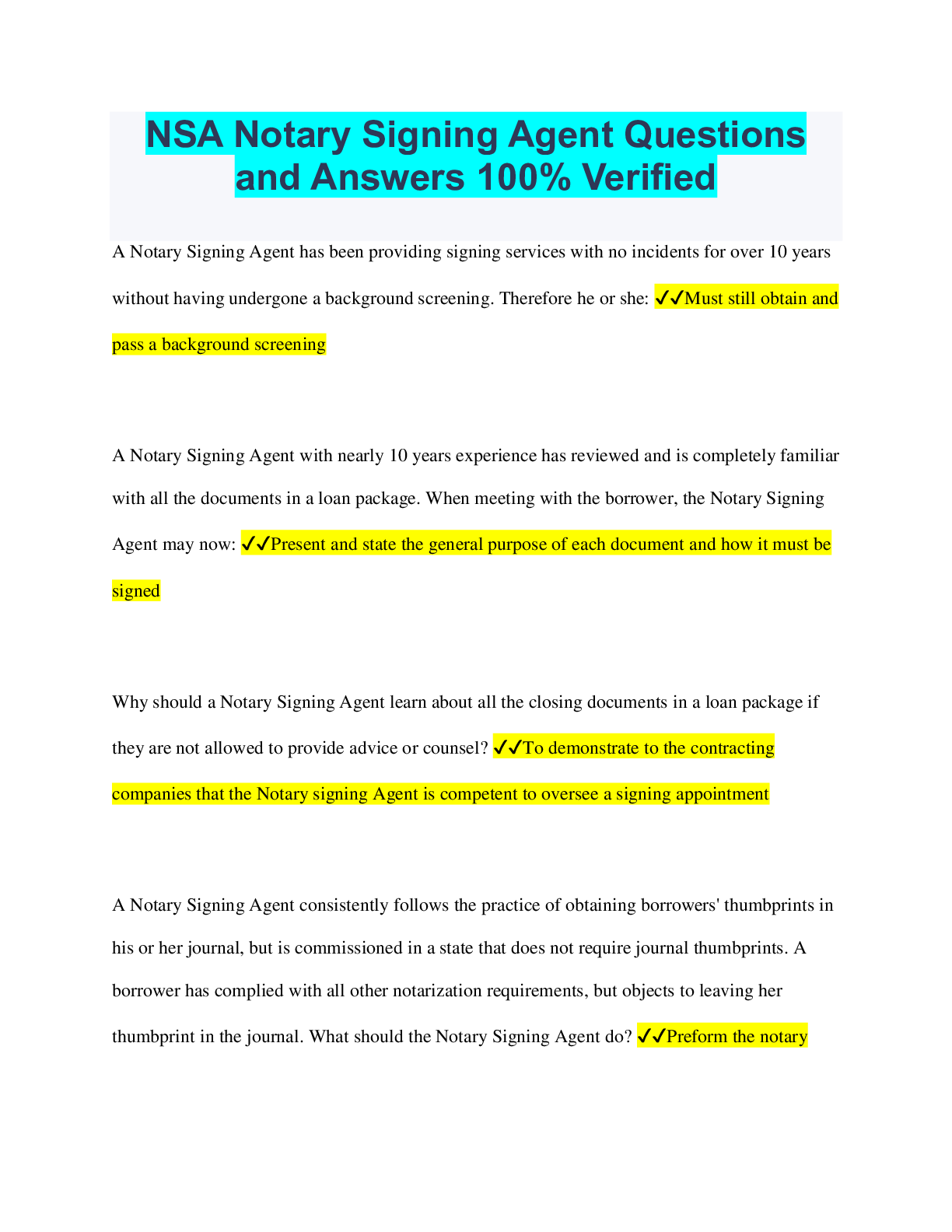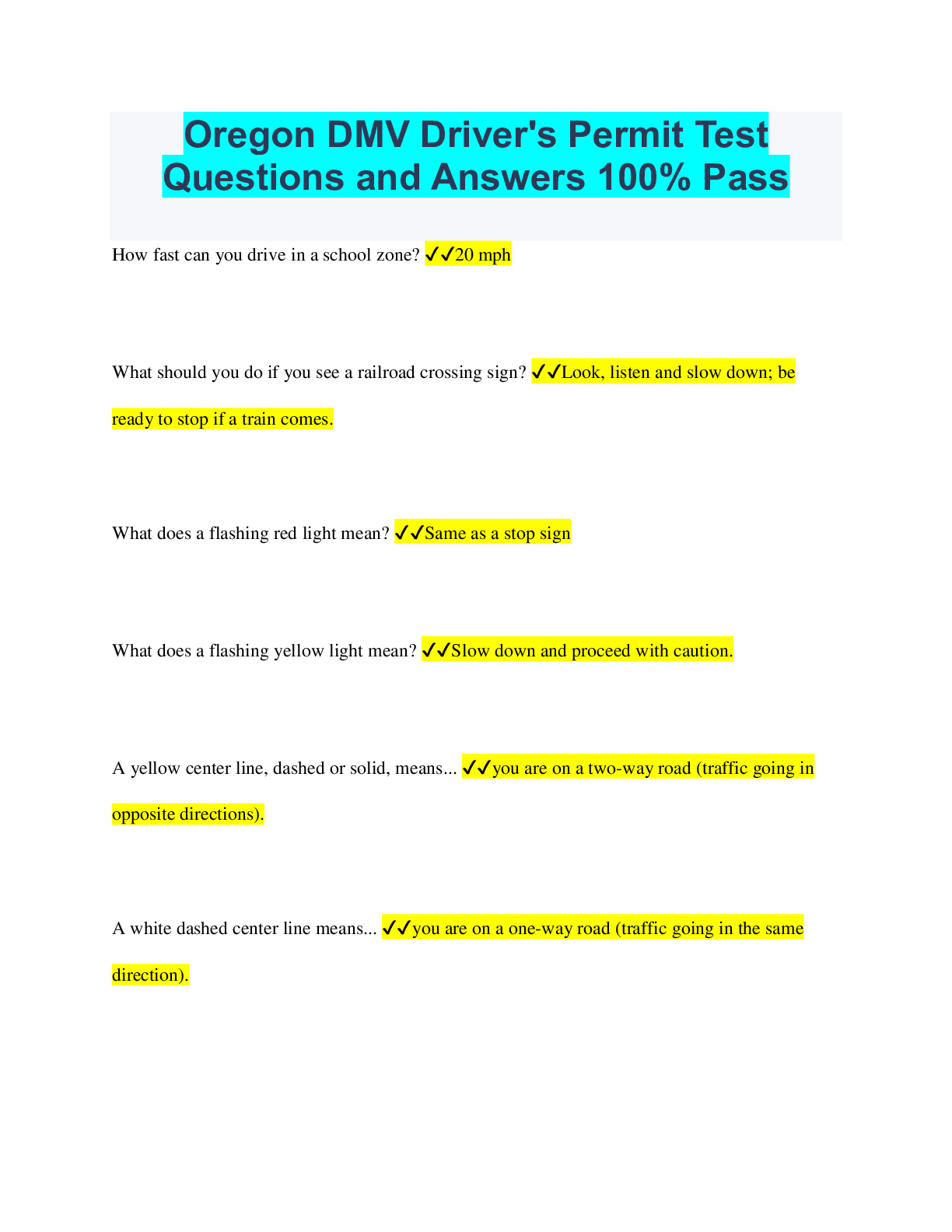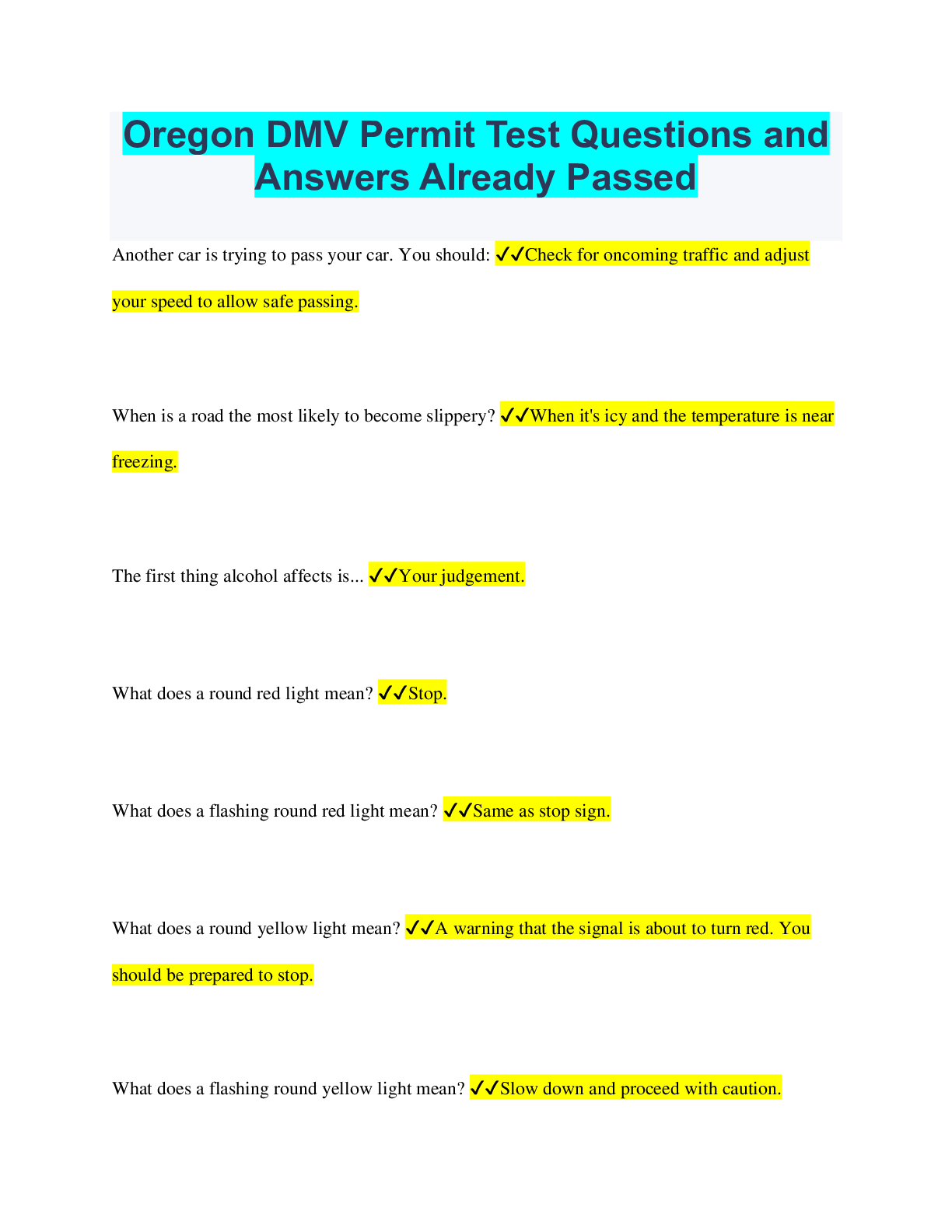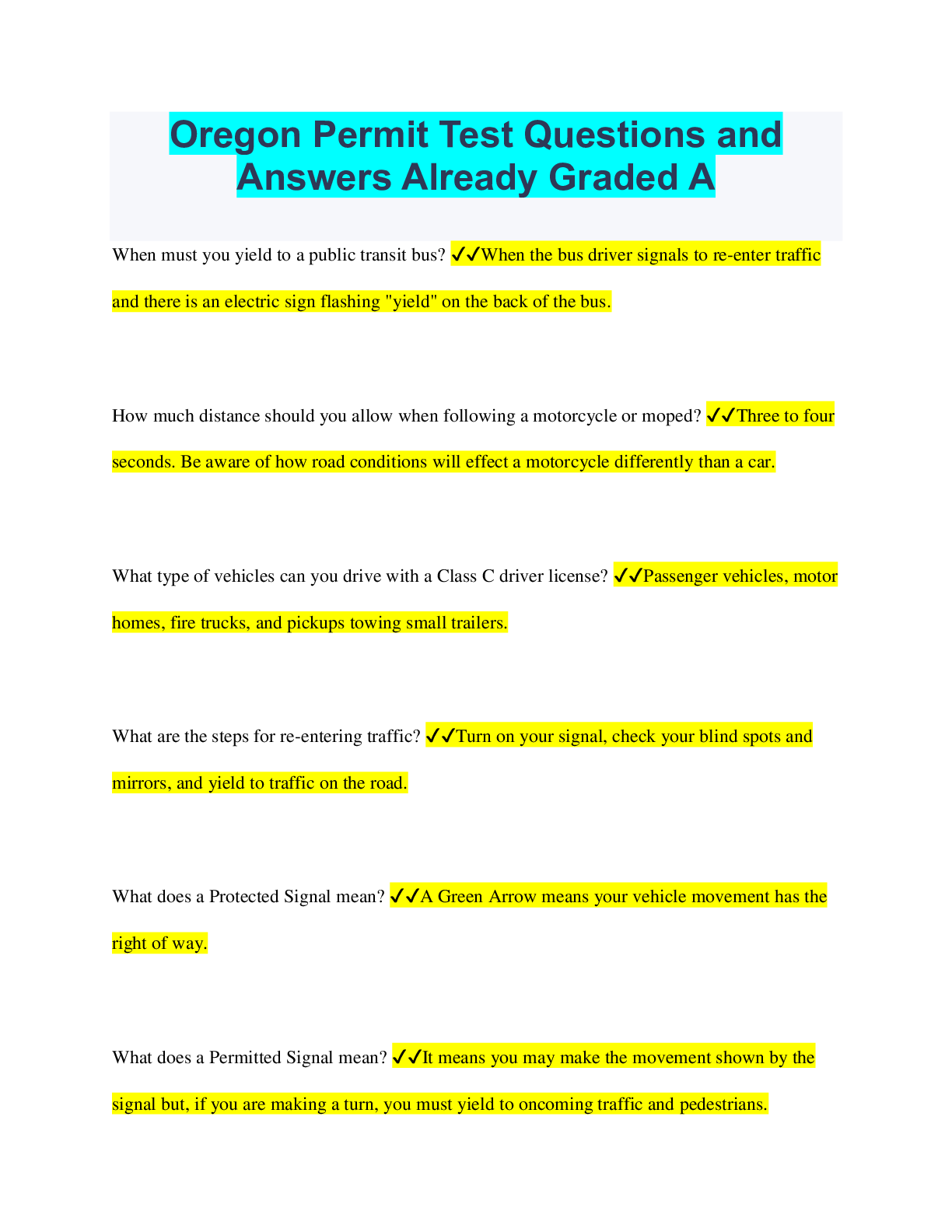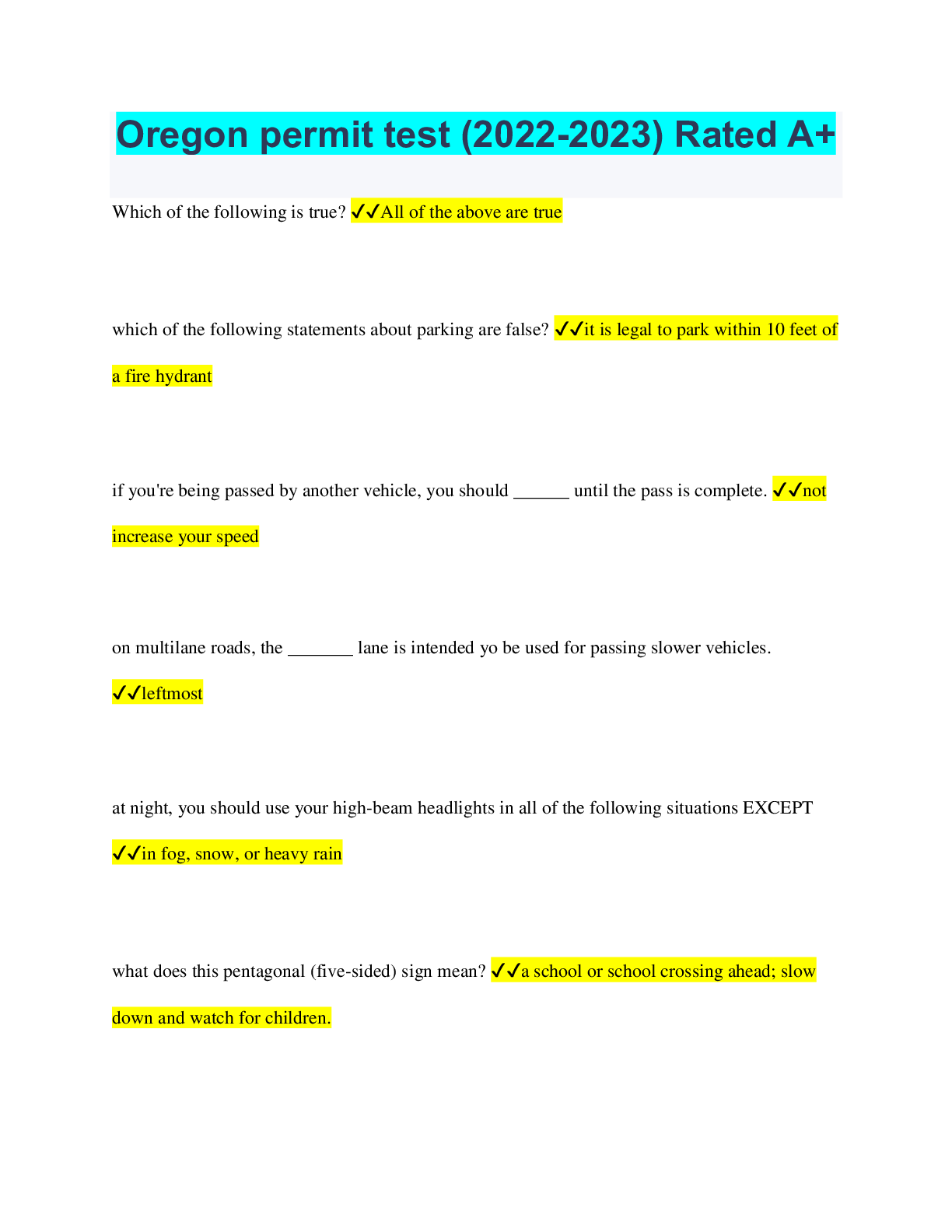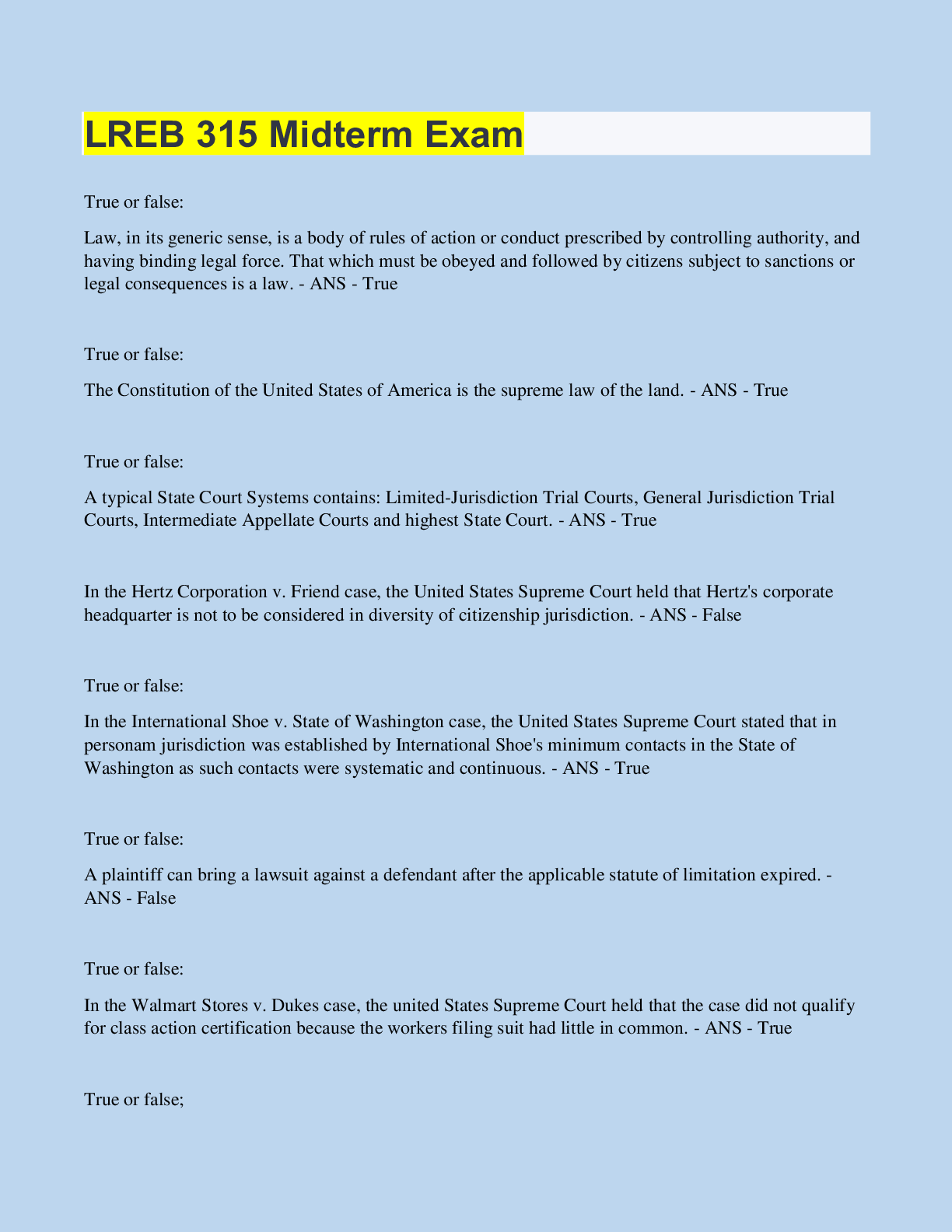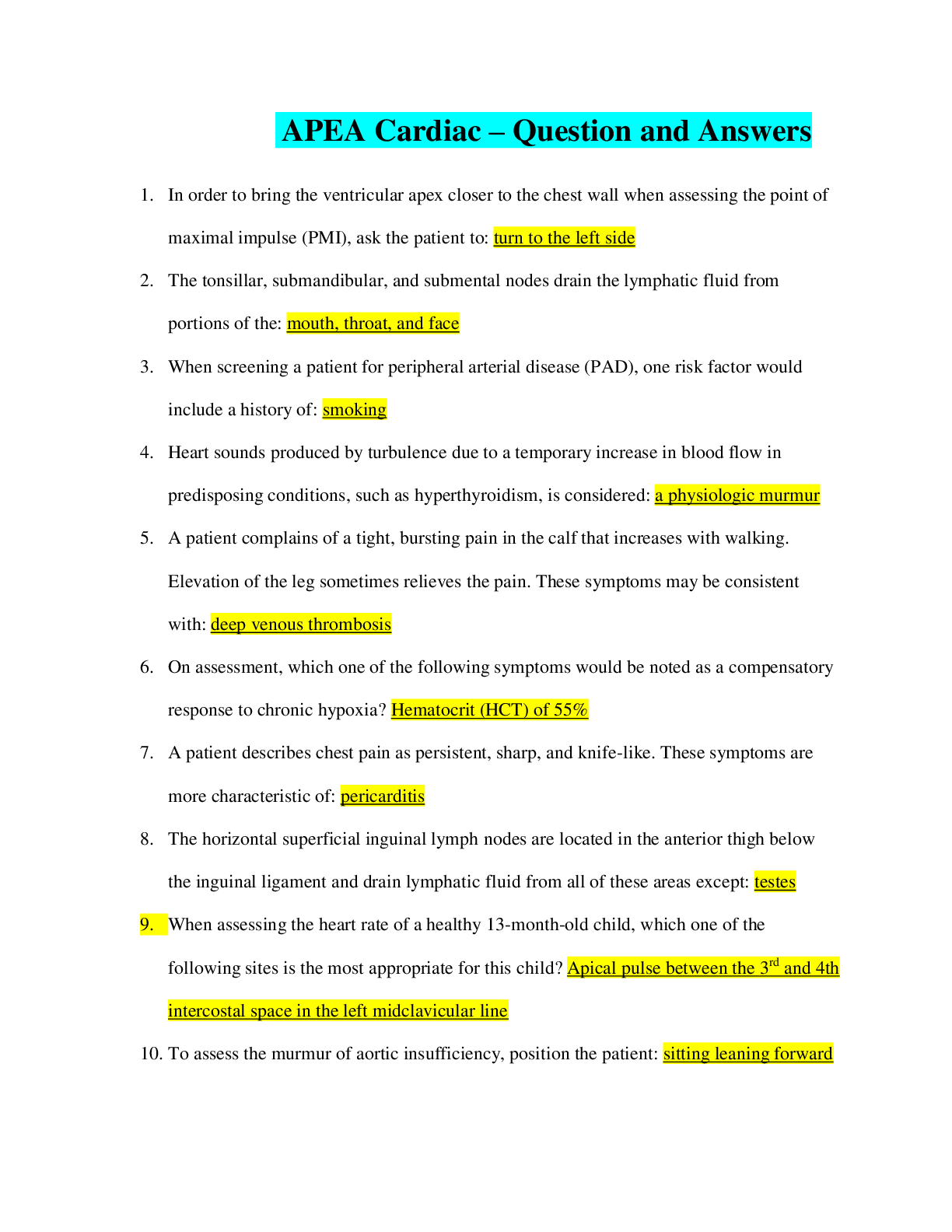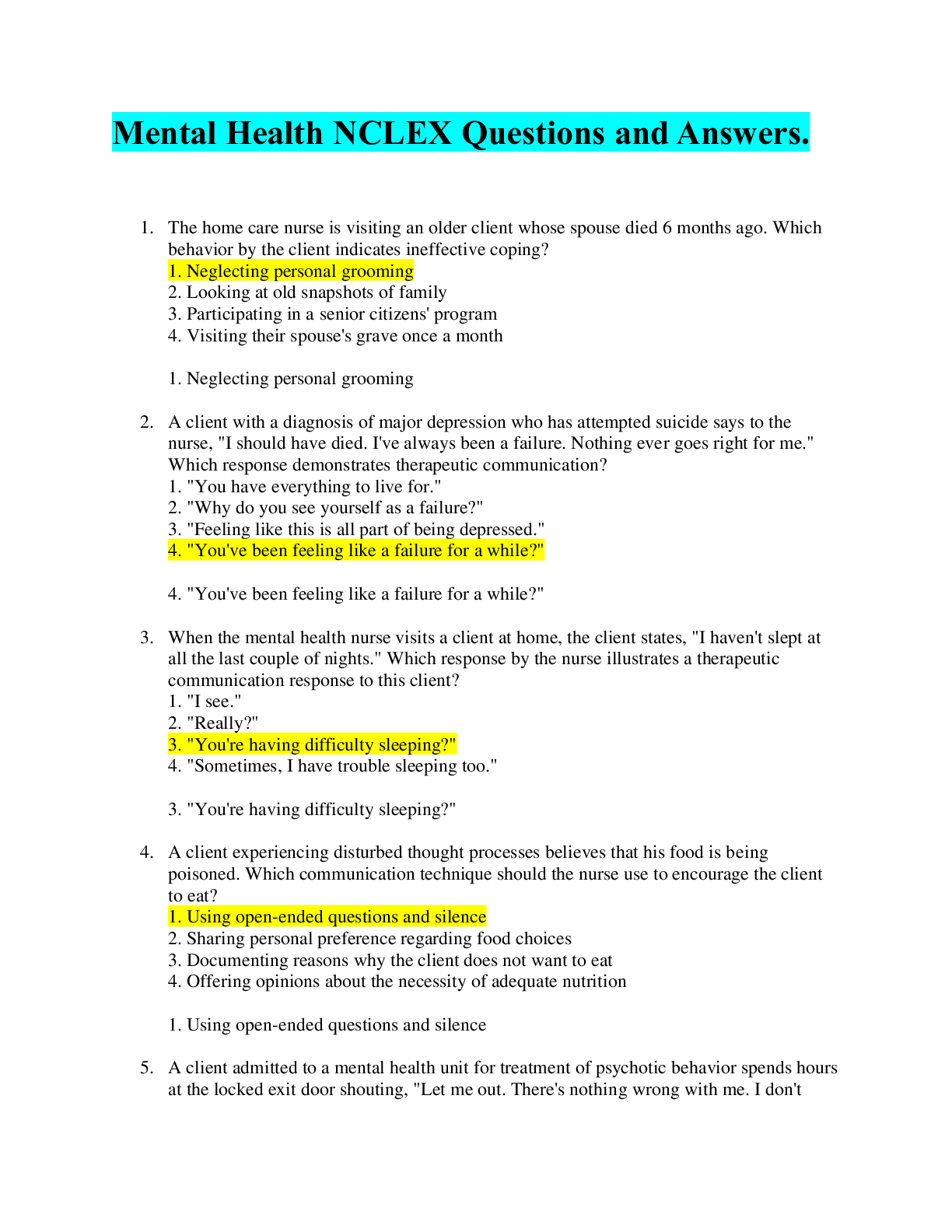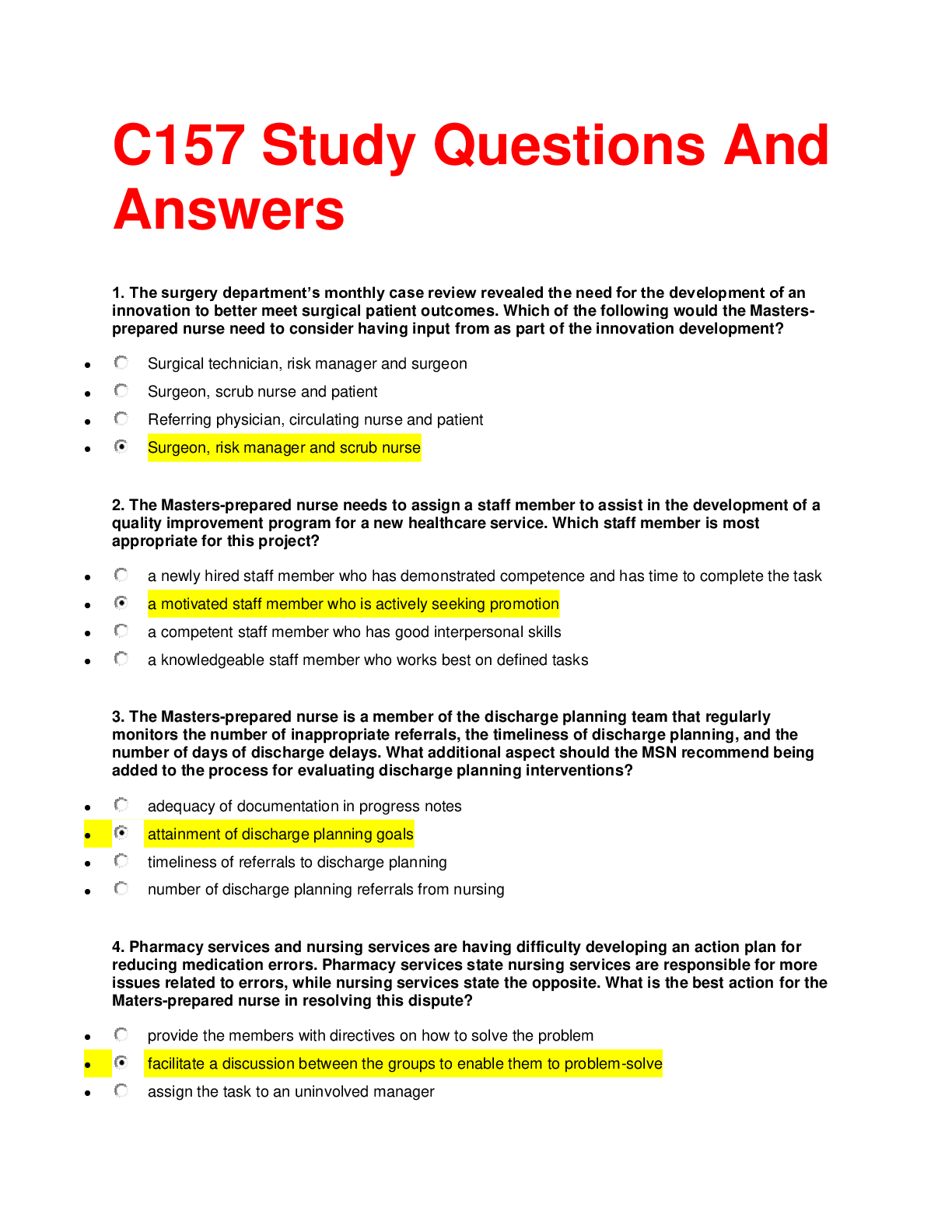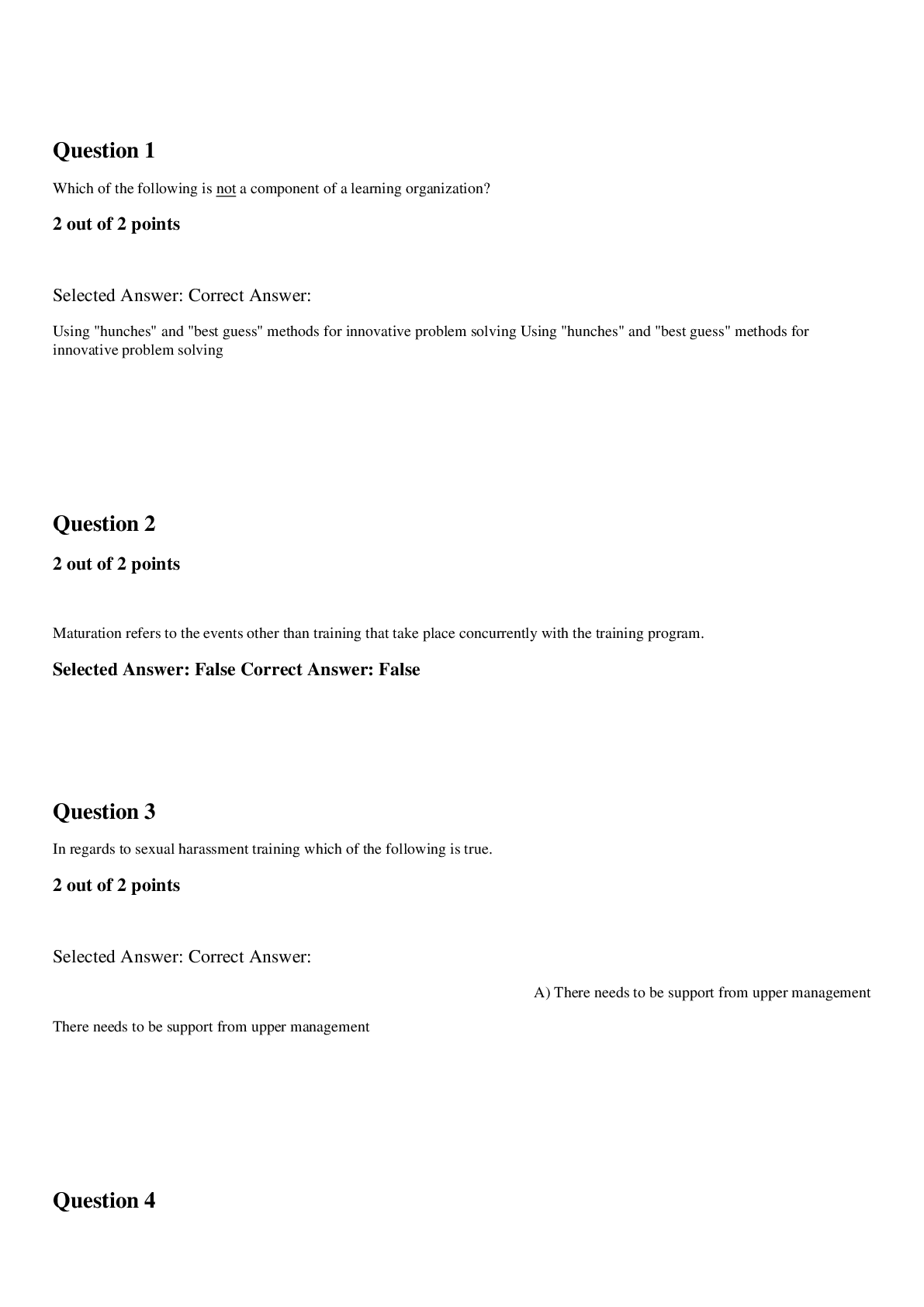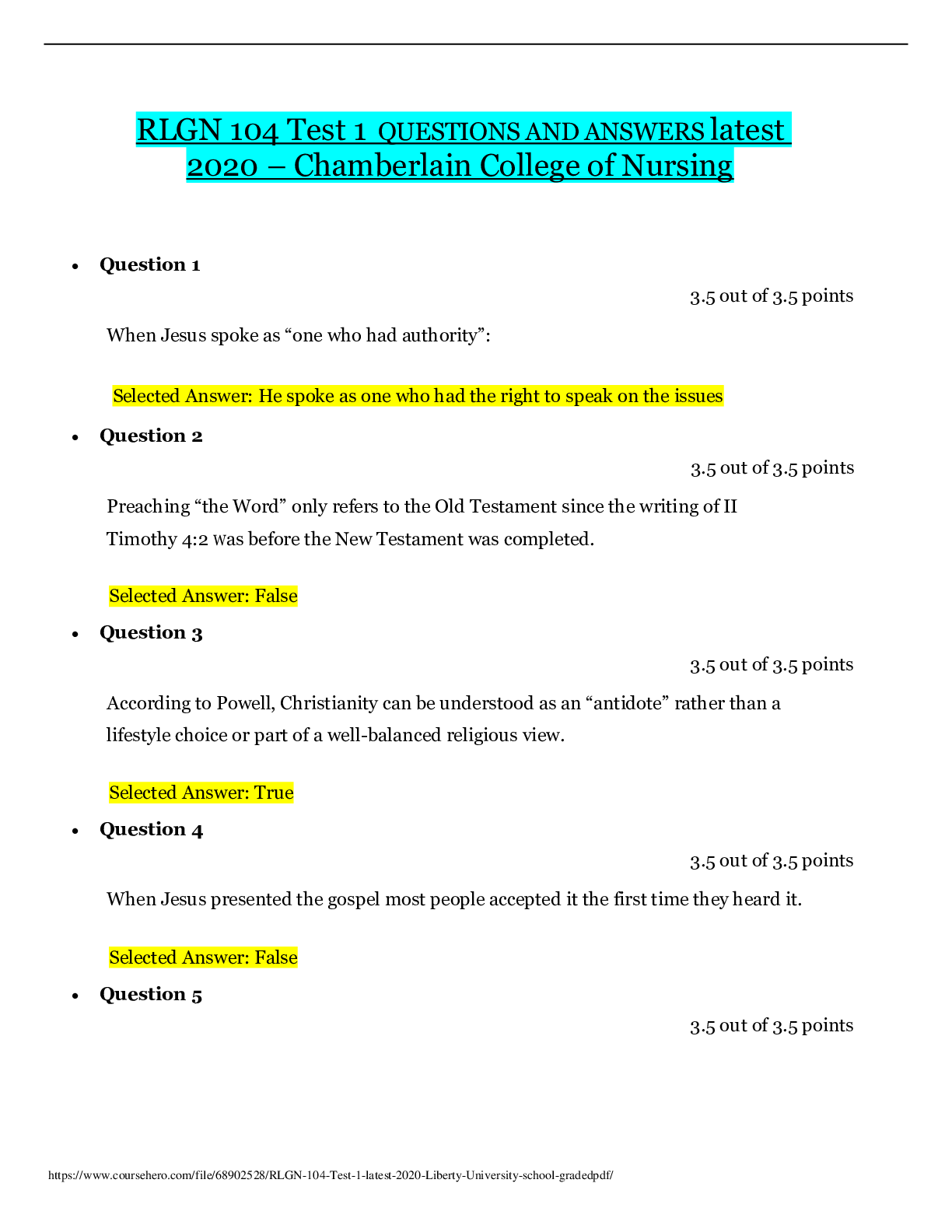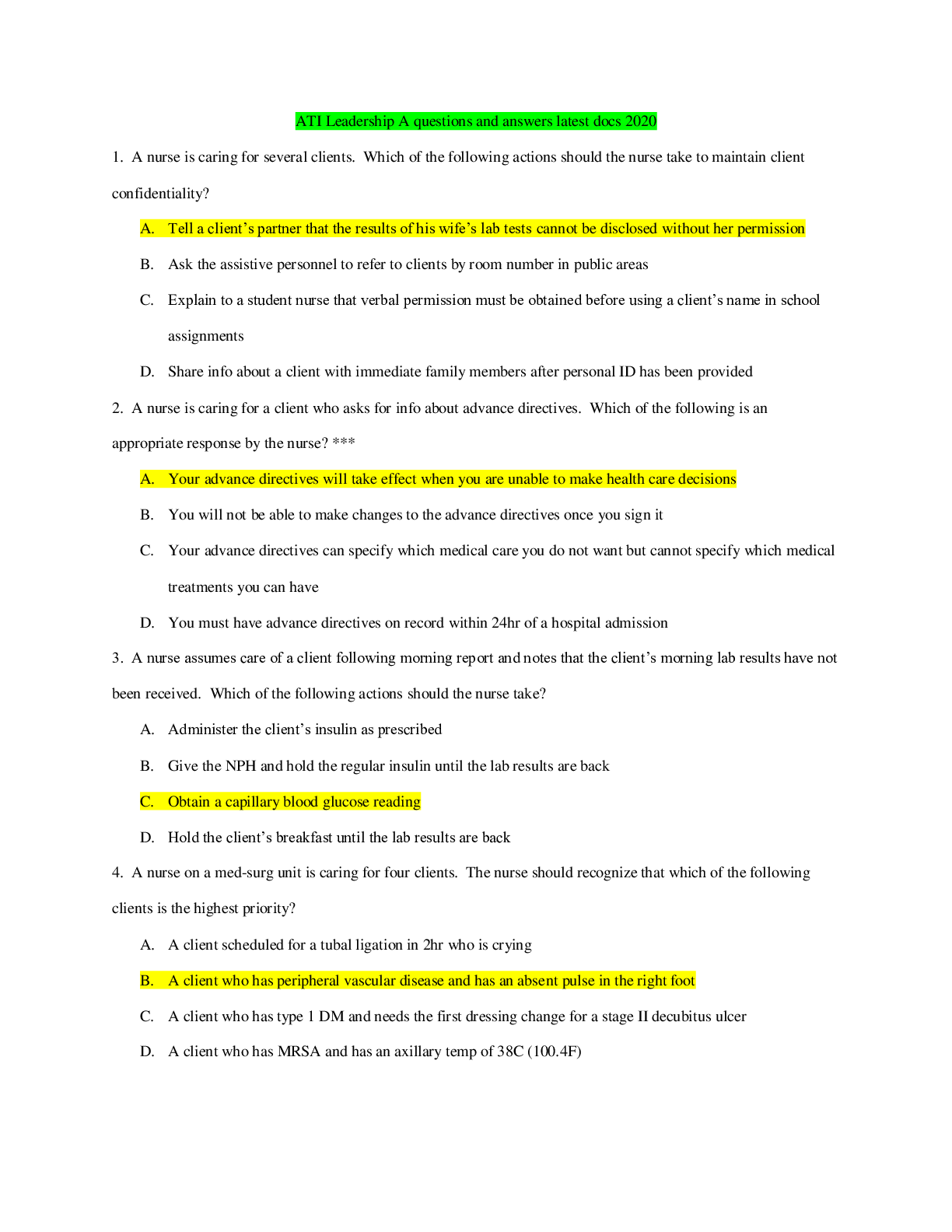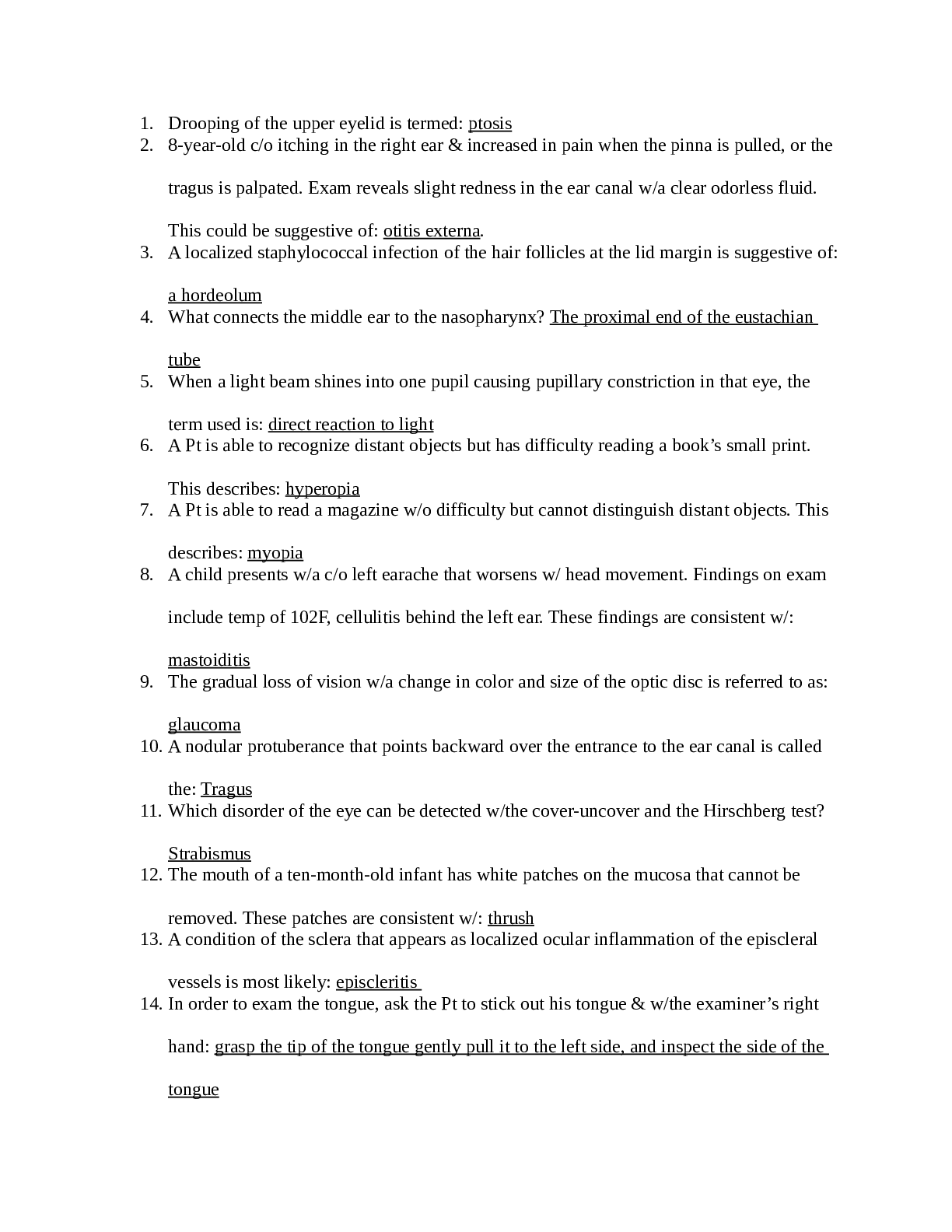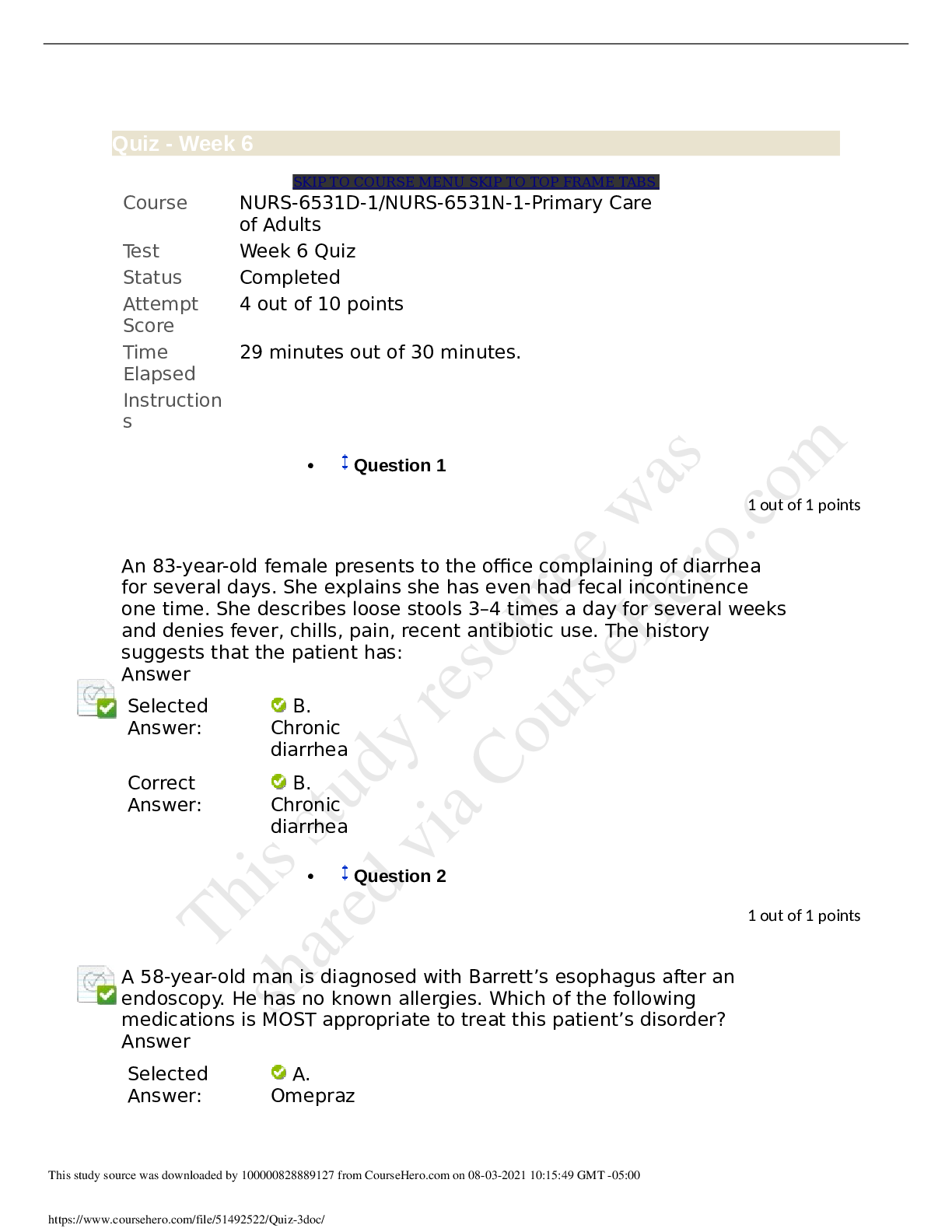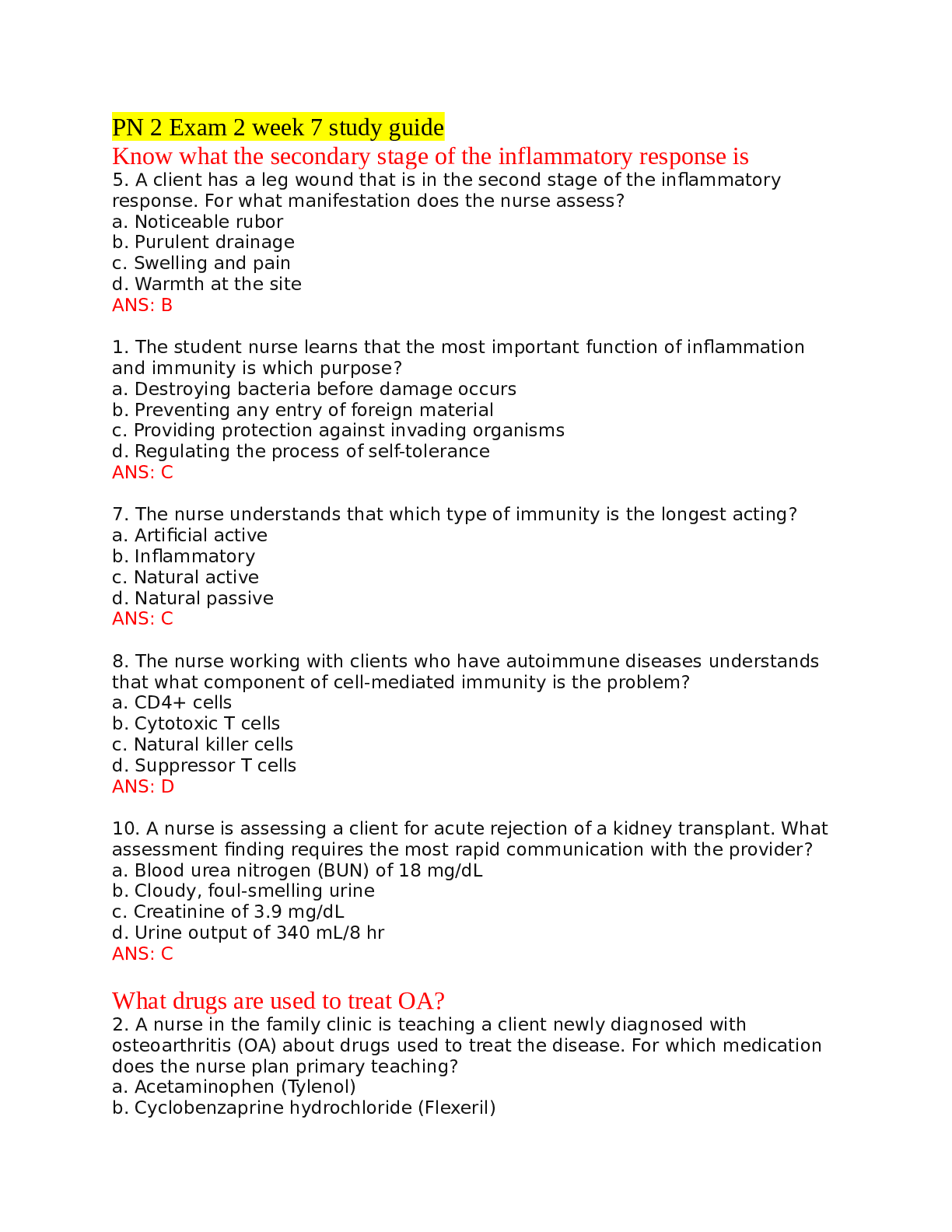Social Sciences > QUESTIONS & ANSWERS > PPR Questions and Answers Latest 2023 Rated A (All)
PPR Questions and Answers Latest 2023 Rated A
Document Content and Description Below
PPR Questions and Answers Latest 2023 Rated A LEP ✔✔Limited English Proficiency ELPS ✔✔English Language Proficiency Standards ELL ✔✔English Language Learner SPED ✔✔Special Educati... on ARD ✔✔Admission, Review, Dismissal IEP ✔✔Individualized Education Program MODS ✔✔Modifications 504 ✔✔Accommodations provided to students who do not respond to remediation. Piaget's Theory of Cognitive Development ✔✔A theory made up of sensorimotor period, preoperational period, concrete operations, and formal operations expressed by Jean Piaget Stages of Play Development ✔✔Unoccupied Play Solitary (Independent Play) Onlooker Play Parallel Play Associative Play Cooperative Play unoccupied play ✔✔when the child is not playing, just observing. A child may be standing in one spot or performing random movements solitary play ✔✔When the child is alone and maintains the focus of its activity. Such a child is uninterested in or is unaware of what others are doing. More common in younger children 2-3 years. Onlooker Play ✔✔When the child watches other at play but does not engage in it. The child may engage in forms of social interaction, such as on about the play, without actually joining the activity. This type of activity is also more common in younger children. Parallel Play ✔✔Adjacent Play or Social Coaction. When the child plays separately from others but close to them and mimicking their actions. This type of play is seen as a transitory stage from a socially immature solitary and onlooker type of play to a more socially mature associative and cooperative type of play. Associative Play ✔✔When the child is interested in the people playing but not in coordinating their activities with those people, or when there is no organized activity at all. There is a substantial amount of interaction involved, but the activities are not in sync. Cooperative Play ✔✔When a child is interested both in the people playing and in the activity they are doing. The activity is organized, and participants have assigned roles. There is also increased self-identification with a group, and a group identifies may emerge. It requires social maturity and more advanced organization skills. Examples would be dramatic play activities with roles, like playing school or a game with rules such as freeze tag. Bloom's Taxonomy ✔✔knowledge, comprehension, application, analysis, synthesis, evaluation TELPAS ✔✔Texas English language Proficiency Assessment System. The legislation requires that ELL'S be assessed yearly in all language skills: listening, speaking, reading, writing. Students are hoped to jump once a year to the next stage. Vertical Alignment ✔✔Kindergarten prepares you for first, first for the second, second for third, and so on and so fourth. Horizontal Alignment ✔✔How Math prepares you for science, science for social studies. All with the specific languages etc.. Sensorimotor Stage ✔✔in Piaget's theory, the stage during which infants know the world mostly in terms of their sensory impressions and motor activities Pre-Operational Stage ✔✔in Piaget's theory, the stage (from about 2 to 6 or 7 years of age) during which a child learns to use language but does not yet comprehend the mental operations of concrete logic Concrete Opperational Stage ✔✔Happens from about seven to eleven years of age. It is characterized by the development of organized and rational thought. Formal Opperational Stage ✔✔Begins at 12 and lasts through adulthood. This is where thinking becomes much more sophisticated and advanced. This test is based on THEORY ✔✔My approach to this is everything is the "Perfect World" Imagine that 100% of admin, teachers, students, parents, were cooperative 100% of the time! HOW DO I EMPOWER MY STUDENTS? ✔✔Set them up for the best 100% of the time. (Despite how the students act, where they come from, we as teachers are leveling an even playing field for all) Practice positive reinforcement. Allow for creative expression Give students more discussion time to explore and develop their ideas Offer more engaging prompts Everything is INTENTIONAL and TARGETED by DATA ✔✔Focus on theory and NOT ON APPLICATION. I set the students desks up like this because we are doing this. Focus on theory! Occupational Therapist (OT) ✔✔Treat injured ill, or disabled patients through therapeutic use of everyday activities. They help these patients develop, recover, improve, as well as maintain skills needed for daily living and working. A Young girl who was shaking while she was writing would see who? ✔✔Occupational Therapist Fine Motor Skills ✔✔Physical abilities involving small body movements, especially of the hands and fingers, such as drawing and picking up a coin (FINGERS) Gross Motor Skills ✔✔physical abilities involving large body movements, such as walking and jumping (ARMS + LEGS) Reporting Abuse and Neglect ✔✔You have 48 hours to report abuse or neglect to the administrator and then to the correct point of authority like CPS Teacher/ Facilitator ✔✔Meant to guide and assist students in learning for themselves, picking apart ideas, forming their own thoughts about them, and owning material through selfexploration and dialogue Teacher/ Monitor ✔✔Expected that monitors act critically, trying to stimulate their classmates to solve the given tasks without providing a direct answer. Teacher/ Evaluator ✔✔ Teacher/ Lecturer ✔✔ Modifications vs. Accommodations ✔✔Modifications mean that you are modifying the actual curriculum. Accommodations means that due to a physical limitation you are NOT changing the curriculum, but accommodating the students such as small groups, different seating, music, etc. Academic Language ✔✔The ability to understand and produce increasingly complex oral and written language. As progress, they are required to understand linguistically and conceptually demanding texts in the content area (math, social studies, science, literature) Acculturation ✔✔A cultural group takes on parts of another culture but does not give up its own way of life Advocacy ✔✔To speak in favor of an issue; a bilingual or ESL teacher will become an advocate for2nd language learners and the programs designed to support 2nd language developement. Fair use provides for ✔✔The copying is only for use in one course The term Public Domain refers to ✔✔Materials with no restrictions on use, materials that teachers can copy and use repeatedly, and materials where the copyright has expired. School personnel can discuss student performance and behavior as long as s for educational interests. ✔✔ What is considered personally identifiable information? ✔✔Name, address, and physical description Correct copyright regulations ✔✔Teachers can make a video, use it within 10 days and erase it within 45 Current copyright law protects a copyright for? ✔✔The lifetime of the originator plus 70 years. A school can publish a student directory as long as... ✔✔The parent(s) sign a permission slip What happens to FERPA protection when the child reaches the age of 18 or enters an institute of higher learning? ✔✔The protection transfers from the parents to the student Which of the following guidelines for the "fair use" of sheet music is accurate? ✔✔Teachers can make emergency copies to replace purchased ones FERPA is also known as the.. ✔✔Buckley Amendment Affective Feelings ✔✔The instruction in the classroom should instill confidence, self assurance, and a positive identity with a students' cultural and language heritage. Affective Filter ✔✔Controls the extent to which an individual internalizes input by converting it into learning. It has been described as an imaginary filter in the brain and when raised it may negatively influence language acquisition, academic success, and classroom behavior and actions. Alphabetic Principle ✔✔Understanding that the sequence of letters is written words represents the sequence of sounds (or phonemes) in spoken words. It is the key to learning to read in many languages, including English and Spanish. ARD ✔✔Admission, Review, and Dismissal committee as established for students in special education. Assessment Bias ✔✔Language learning only serves t "edit" speech that has been acquired. Fluency comes from acquired, not learned, language. Assimilation ✔✔Group of people gives up most of their culture and way of life and take on the culture of another group. Bicultural Identify ✔✔Development of cultural values and socialization practices of the majority culture and the culture of the student. It is the ability to cope with the differing demands of more than one culture. Biculturalism ✔✔Ability to negotiate effectively within two different cultural systems. Bilingual Education ✔✔Education setting where students are instructed for some part of the day in their native language. In the US, students receive instruction their L1 and in English as a 2nd language. Biliteracy ✔✔Ability to read and write with high levels of proficiency in two languages through the appropriate and effective use of the grammatical, syntactic, graphophonic, semantic, and pragmatic systems of two languages. Chapter 89 ✔✔Commissioner's Rules concerning Limited English Proficient students. It describes the plan for educating LEP students in Texas. CLD ✔✔Culturally and Linguistically Diverse Code Switching ✔✔Alternate use of two languages interchangeably or simultaneously that occurs among bilinguals. Includes any switch between two languages at the level of words, sentences, or blocks of speech. Cognates ✔✔Words that are related in meaning and form to words in one or more language due to their common historical morphemic sources. Example: Animal in English and Animals in Spanish are cognates. Cognition ✔✔Knowing, understanding, perceiving, or conceiving. Communicative Competences ✔✔Competency in this area is demonstrated by the ability to use language in socially appropriate ways for communicative purposes. Comprehensible Input ✔✔Language that a learner is able to understand with the aid of contextual clues such as body language, gestures, context or prior knowledge. Contextualized Language ✔✔People acquire a 2nd language are influenced by many factors. Personality traits can influence L2 acquisition. Literacy experiences in the L1 will influence L2 acquisition. Age may influence L2 acquisition. Learning a language as a child generally means native-like pronunciation. Cultural Background ✔✔Whether a child is an immigrant or native-born, each child brings his/her own history and culture to the classroom. Be sensitive to cultural differences and recognize that some students may not wish to be identified as different from their classmates. Cultural Bias ✔✔Good intentions, but lacking a solid foundation of cultural knowledge can cause cultural bias. Teachers must educate themselves on culture to avoid bias. Cultural Diversity ✔✔Presence of different cultural groups in an area. Cultural diversity affects the classroom and creates a climate in both the diversity and the similarities of groups and individuals are appreciated. Idiomatic Expressions ✔✔Expressions that are peculiar to or characteristic of a given language. Idiomatic expressions are difficult to translate literally, so this can pose a problem for L2 learners. Inhibition ✔✔2nd language students may restrain or hold back when using a 2nd language. The environment or perceptions of fear may cause inhibition. Interrelatedness of listening, speaking, reading, and writing ✔✔Relationships between listening, speaking, reading, and writing during development are complex relationships of mutual support. Practice in one process contributes to the overall base of second language knowledge. It is important to provide exposure to functional meaningful uses of both oral and written language. Language Proficiency ✔✔Proficiency in language is assessed to determine a students ability to function in the language. Proficiency in comprehension, speaking, reading, and composition in the English language is the goal of English as a Second Language Programs. Language Proficiency Assessment Committee (LPAC) ✔✔Districts are required to establish and operate a LPAC. THe local board will have on file policy and procedures for the selection, appointment, and training members. Language Status ✔✔Relative standing or position of a language in regards to the majority culture Learning Styles ✔✔Planning for a different learning styles represented in a classroom can assist the teacher in targeted, instructional planning that anticipates the learning styles and helps to make modifications that are cross-culturally sensitive and can be effective in reducing the need for re-teaching. Lexicon ✔✔The terms used in a particular profession, subject or style: vocabulary Linguistic diversity ✔✔The presence of different language groups in an area. Linguistic Environment ✔✔The environment should support L2 acquisition. Give instructions clearly and precisely. Use open-ended questions and encourage responses. Provide activities where the language is predictable or repetitive Use activities that involve real conversation and focus on meaning. Rely on cooperative learning. Lingustics ✔✔The structural aspects of language Daily Routines ✔✔Enhance awareness of the forms and functions of print. THe use of routines in the classroom can highlight for your students how literacy serves everyday purposes. Decontextualized Language ✔✔Type of language used in an environment where the words stand on their own without support from the non linguistic context. Diagnosis ✔✔Process of determining or analyzing a student's performance level or level of language proficiency Dialect ✔✔Variation of a language used by a particular group of people Discourse ✔✔Conversations or verbal expression in speech or writing; the language used to engage in a conversation. Linguistically, it is described as a connected series of utterances. It can be described as talking, conversing, speaking, or writing. English as a Second Language ✔✔Programs that provide instruction in one language. All programs in this category are considered subtractive because they promote monolingualism in English. Programs were designed for English Language Learners who speak with same language or speak different languages. Ethnocentism ✔✔The belief that one's own culture belief is superior to every other culture or group Expressive Language ✔✔Language that is generated in the form of speaking, writing, or signing. Family Literacy ✔✔Literacy practices that occur in the home including writing letters, lists, reading labels, magazines, newspapers, and boks. Activities are known to promote and support literacy development. Function ✔✔COmmunicative competence theory has given rise to communicative language teaching involving social function of language. THis can include requesting, telling a story, expressing joy or disappointment and expressing an opinion. High Frequency Words ✔✔Words that are used often in text. Beginning readers will build a vocabulary of recognized sight words and high frequency words. Home Language Survey (HLS) ✔✔Required of every student enrolling in Texas Public schools. "What language is spoken in your home most of the time?" and "What language does your child/ you speak most of the time?" Idiolect ✔✔Individual's particular speech Literacy Development ✔✔Ability to read and write with high levels of proficiency through the effective use of grammatical, syntactic, graphophonic, semantic, and pragmatic systems. LPAC ✔✔Language Proficiency Assessment Committee Metalinguistic ✔✔Conscious awareness of how language works Morphology ✔✔The structure of meaningful units and patterns in words. Example: "talk" is one morpheme and "talked" is 2 morphemes "talk" and "ed" Motivate ✔✔Means to stimulate to action or provide with an incentive. 2nd language students need to be motivated to learn the L2. Many factors influence motivation. Native Language/ Primary Language ✔✔Language a student learned in the home. Primary language is also referred to as L1 (first language) NEP ✔✔Non-English Proficient NES ✔✔NonEnglish Speaker. A student who has little or no proficiency in the English Language. Newcomer Centers ✔✔ELL in these centers may speak the same or different languages. They are designed to promote survival English and are for short term placement. Nonlinguistic ✔✔Includes gestures, facial expressions, and body language and their relationships to a language. Notional Fuctional ✔✔Pragmatics of language organized around functions of language: agree, argue, questions, compliment, express emotions. Learn communication strategies for various situations. Notional categories of language: time, quantity, space, matter, etc. Oral Language ✔✔Focus on cooperation, open-ended communication interaction, and the teacher should act as a facilitator Paralinguistic ✔✔Study of intonation, stress, rate of speech, pauses, and hesitations and their relationships to language Parental Involvement ✔✔Family members are encouraged to participate in school acivities. Parents contribute ideas about culture, traditions, and interests for school shows, written communications, and displays. Phonological awareness ✔✔Ability to recognize the sounds of spoken language and how they can be blended together, segmented and manipulated. It does not involve print. It begins before students have learned a set of letter-sound correspondences by using manipulatives. Phonology ✔✔Rule system of speech sounds in a language. Example: Identify all the sounds that "a" makes. Pragmatics ✔✔Use of language in social contexts. It is determined by the function or an interaction and by the relationship of the people involved. Prejudice ✔✔An attitude about others which is formed unfairly, and discrimination, the behavior arising from prejudice, go hand in hand. Proficiency ✔✔High degree of competence achieved through training and practice. Assessment of language can help determine level of proficiency. Promoting Literacy ✔✔Promote literacy in the L1 and L2 by providing a print-rich environment, opportunities for collaboration, engaging literature in a meaningful way and opportunities for writing purposefully. Psychololinguistics ✔✔Study of the relationship of language and the mind. The area of psycholinguistics includes how language is acquired and processed in the human mind. Realia ✔✔Actual physical objects Receptive Language ✔✔Ability to understand a message Register ✔✔Use of different varieties of language, depending on the setting, the relationship to the person to whom they are speaking, and the function of the interaction. A register is a situational appropriate form of the language. Respect for Diversity ✔✔The teacher knows how to use diversity inside and outside the ESL classroom to create an environment that nurtures a sense of community, respects differences, fosters an appreciation of their own culture and the culture of others. Scaffolding ✔✔When children are learning a 1st language, parents help young children verbally elaborate on a topic, thereby facilitating communication at a more sophisticated level. When a parent provides a scaffold, elaborating what the child has said, they are unconsciously modeling linguistic and conversational patterns through natural social interaction with the child. THe same process takes place in a classroom with a 2nd language learner acquiring English. The teacher will encourage interactions and then support and elaborate. SDAIE ✔✔(Specially Designed Academic Instruction in English) Strategies that have been developed to foster 2nd language development and academic learning by using the 2nd language for instruction making sure it is comprehensible to 2nd language learners. Second Language Acquisition ✔✔People learn a second language by using what they already know about their first language and by going through some of the same stages of first language development. Self Esteem ✔✔2nd language students should have pride in regards to language and culture. Self-esteem is pride in oneself. Semantics ✔✔The study of meaning; some words can have multiple meanings Sheltered English ✔✔to facilitate access to core curriculum for L2 learners intermediate level of English required slow but natural levels of speech clear enunciation, short sentences controlled vocabulary visuals frequent comprehension checks low level of anxiety cooperative learning should be integral part content is not watered down Sheltered Instruction ✔✔Instructional approach used to make academic instruction in English understandable to ELL's This type of instruction includes the use of physical activities, realia, visuals, and graphic organizers to teach new vocabulary, concepts, and information. Method can be used in math, history, science and other content areas. Sight Words ✔✔Word which is easily recognized and becomes a word in an ever developing sight word vocabulary. Silent Period ✔✔Stage of about one to twelve months in which the second language learner works to receive and understand the new language, but there is little or no expressive language. Social Language ✔✔The ability to carry on a conversation in familiar, predictable, face-to-face situations. Usually developed by the time a child enters school. Sociolect ✔✔Language that varies among different social groups Sociolinguistics ✔✔The study of how language works in society; The language dynamics of everyday interactions between people. Stereotyping ✔✔Ideas that all memebers of a cultural group are the same. It usually promotes negative feelings about a particular culture or group. Syntax ✔✔THe manner in which words and other structural elements of a language are arranged to construct sentences. Targeted Language/ Second Language ✔✔2ns language that is being acquired or learned. For ELL in the US, the targeted language is English. L2 is the target language a student learns Technology ✔✔Second language learners should have access to computer-assisted instruction, including tutorial software to increase opportunities for practice and feedback. It includes using tools to assist students with word processing and to provide writing opportunities. Transfer of language skills from L1 to L2 ✔✔People learn a second language by using what they already know about their first language and by going through some of the stages of first language development. Content area knowledge, concepts, and skills can be transferred to another language. When a child is literate and educated in their first language, they will transfer those skills to their second language. Visual Support ✔✔LEP students need visuals (pictures, videos, demonstrations, charts, etc) to help them understand abstract ideas. Written Language ✔✔Activities should focus on language acquisition through materials that are meaningful, personalized, or culturally relevant. Ability Grouping ✔✔A type of grouping where students are placed together according to their skill level, in high, middle or low groups. The TExES exam does not like this practice as research indicates that it is not very effective and has some negative consequences. Abstract ✔✔Characterized only in thought; non-concrete Active Engagement ✔✔Participating in the current activity; being actively involved in the current learning process Active Learning ✔✔Participating in the current activity so the information or concept is committed to memory Active Listening ✔✔Paying close attention to what is currently being said so the information or concept is committed to memory Active Student Inquiry ✔✔Students are engaged in an activity, asking and likely answering questions Advanced Organizer ✔✔Structure providing a preview of the upcoming lesson Age Appropriate ✔✔Vocabulary, lessons, activities that fit the development, language and ability level of the child. Alternative Assessment ✔✔A type of evaluation other than a conventional test Analogy ✔✔A logical comparison inferring that if two things are known to be alike in some ways, then they must be alike in other ways Analysis ✔✔Taking knowledge apart to understand how it fits together Application ✔✔Applying what is known to solve a problem Assessment ✔✔A way of monitoring progress; the act of testing, determining an evaluation of a particular skill or content area; includes authentic evaluation procedures (using evaluation procedures that measure exactly what learning has occured) Autonomy ✔✔The process of becoming independent and regulating one's own behavior Bias ✔✔A preference that affects one's impartial judgement Bloom Taxonomy ✔✔A classification tool developed to categorize learning from low level thinking to very high level thinking Brainstorming ✔✔A risk free discussion of ideas that relates to a particular topic or concept Classroom Management ✔✔It consists of practices and procedures that a teacher uses to maintain an environment in which instruction and learning can occur Collaborate ✔✔To work together Comprehension ✔✔The act of understanding Concrete Activity ✔✔Usually a hands-on experience where students can actually manipulate materials in order to gain a better understanding of the concept being taught Constructivism ✔✔A theory based on the idea that children build understanding by an active learning process Content Validity ✔✔How ell a test measures what is and was designed to measure Convergent Thinking ✔✔THinking that is framed so that several different people will arrive at the same time. Cooperative Learning ✔✔Grouping children together in small groups to learn from one another Critical Thinking ✔✔Evaluating information and logically solving problems Criterion References Assessment ✔✔Standardized measure of specific skill or content Deductive Reasoning ✔✔The process of thinking from general terms to specific terms; Framing thinking so as to eliminate ideas or possibilities one by one Discovery Learning ✔✔A teaching strategy that allows students to learn by their own active exploration of a concept Divergent Thinking ✔✔THinking that is framed so that numerous people could come up with numerous responses Diversity ✔✔The quality of being different Ecletic ✔✔Using a variety of sources Educator's Code of Ethics ✔✔THe standards which all educators must adhere to in relation to their ethical conduct Effective Teaching ✔✔An educator who can understand and communicate to the learner concepts and ideas which will produce an intended learning outcome Empower ✔✔To have control or to be confident in one's own abilities ESL ✔✔A program for teaching the English language to children whose first language is not English Ethical Behavior ✔✔Acting in the highest moral principals and values Evaluation ✔✔Critical thinking that involves making and supporting judgments Explicit ✔✔Clearly defined or direct Extrinsic Motivation ✔✔Wanting to do something, behaving a certain way or achieving something because of some type pf external reward which results in personal gain Feedback ✔✔Information about the result of a performance Formal Assessment ✔✔Measuring skill acquisition by means of a standardized test Formative Assessment ✔✔Monitoring progress before and during learning in oder to guide any necessary adjustments and the pace of the learning Graphic Organizers ✔✔Some type of visual display that help students quickly understand a concept or topic Grouping ✔✔Placing students together in order to accomplish something Hands on Activities ✔✔Activities designed so that students actually perform the planned activity Heterogeneous Grouping ✔✔Grouping students with unlike characteristic or abilities Homogeneous Grouping ✔✔Grouping students with the characteristics or abilities that that are similar Implicit ✔✔Implied or suggested byt not directly indicated Impulsivity ✔✔A tendency to respond quickly without thinking Instruction ✔✔How we teach the curriculum Instructional Objects ✔✔Written statements about how and what a teacher will teach to the students Instructional Strategy ✔✔The plan for teaching; the methodology and process for teaching Internalize ✔✔To take in or absorb and make part of one's beliefs or attitudes Intrinsic Motivation ✔✔A desire to do something that comes from within oneself Knowledge ✔✔Simple recall of information Learner Centered ✔✔The learning activity or concept is based on the abilities, needs and learning style of students. Modality ✔✔Preferred ways of learning such as seeing (visual), hearing (auditory), touching (tactile), or moving (kinesthetic) Modeling ✔✔SHowing how to do something Modification ✔✔A change in a lesson made to accommodate the needs of a special education student Norm Referred ✔✔Standardized test whose results compare the student's score to a defined norm group (SAT or ACT) Objectivity ✔✔Perceiving something without being influenced by personal opinions Open Ended Question ✔✔A question having more than one correct response in order to encourage critical thinking and problem solving Paradigm ✔✔An example, pattern, or framework for thinking Jean Piaget ✔✔A Swiss biologist who became interested in psychology and ultimately became very interested in the reasoning skills of elementary children Portfolio ✔✔A collection of one's work over a period of time Precocious ✔✔Advanced in development Prior Knowledge ✔✔What the students already known can be accessed by the KWL chart KWL Chart ✔✔Stands for "What I KNOW, what I WANT to know, and what I LEARNED. It is is a type of graphic organizer to assist students in monitoring their reading comprehension Project Learning ✔✔An in-depth study in an area of interest done independently or in small groups Rationale ✔✔Reason behind a lesson or rule Reflection ✔✔TO think back and carefully consider specifics of teaching and learning Reliability ✔✔A test characteristic that measures dependability Rote Learning ✔✔Memorizing facts or associations Rubric ✔✔The guidelines that will be used for assessment Scope ✔✔Amount covered by a given activity or subject Self-Directed Learning ✔✔The process of gradually shifting responsibility for learning to the students through activities that engage them in increasingly complex patterns of thoughts. Student Centered ✔✔Focused on all students Student Ownership ✔✔Taking control of the learning process Summative Assessment ✔✔Formal or informal evaluation occuring at the end of the unit of study Synthsis ✔✔Higher level thinking that requires putting pieces together to form a whole Teacher Bias ✔✔Expectations of abilities of students based on some outward appearance Teacher-Centered ✔✔Traditional teaching style in which teachers make all of the decisions focusing on the subject Terminology ✔✔Vocabulary of technical terms used in a particular field Validity ✔✔The extent or degree to which an assessment tool measures what it is supposped to measure Vicarious Learning ✔✔Learning by watching someone else, without direct experience. TELPAS Level Descriptors ✔✔Beginning, Intermediate, Advanced, and Advanced High TELPAS (Beginning) ✔✔Beginning English Language Learners (ELL's) have little or no ability to understand spoken English used in academic and social settings TELPAS (Intermediate) ✔✔Intermediate ELL's have the ability to understand simple, highfrequency spoken English used in routine academic and social settings TELPAS (Advanced) ✔✔Advanced ELL's have the ability to understand, with second language acquisition support, grade-appropriate spoken English used in academic and social settings. TELPAS (Advanced High) ✔✔Advanced high ELL's have the ability to understand, with minimal second language acquisition support, grade-appropriate spoken English used in academic and social settings. Preoperational Stage ✔✔Two - Seven. Students become eocentric, thinking that the world revolves around them. They have a hard time thinking outside the box. They need to see things work to understand the process. They have a hard time empathizing with others and are slow learners in situations. They need many hands-on activities. Direct instruction, should be paired with experiments and activities to reinforce instruction. Concrete Operations ✔✔First Grade to Adolescence. Students begin to think abstractly. They can start to mentally picture how things work and do not need to always see or physically manipulate objects to understand them. They are able to consider different points of view and empathize more with other individuals. Inductive reasoning happens which is being able to decide if a conclusion is correct or incorrect based on supporting evidence. Students at this age do not need as many hands on activities Formal Operations ✔✔Ages 12 and up. Students at this stage can use inductive and deductive logic, think abstractly, and empathize with others. Instruction does not need to be reinforced with hands-on activities. They are able to understand processes through abstract thinking which is the maturation of cognitive development. Instruction should reflect and utilize this advanced mental ability. A child's mental maturation takes time, and each child is different in maturation. This progression is slow, why middle schoolers may be at different cognitive stages, and instruction will need to be varied to meet the learning needs of each student. Deductive Reasoning ✔✔reasoning in which a conclusion is reached by stating a general principle and then applying that principle to a specific case (The sun rises every morning; therefore, the sun will rise on Tuesday morning.) inductive reasoning ✔✔A type of logic in which generalizations are based on a large number of specific observations. Individual Development ✔✔Not all students will be able to function on the same level of cognitive ability or accept the same amount of responsibility. Remember to answer questions with a learner centered response. A learner centered response generally has the teacher promote a specific instructional concept and allow for individual students to be able to participate on the level of their development. Students will have varying levels of cognitive ability. Example: Most students in an eight-grade science class will be able to understand the abstract concepts of physics (abstract thought occurs in the formal operations development). However, it is best to reinforce concepts with physical demonstrations to ensure that students who might not be as developmentally mature can grasp the concepts. Solitary Play ✔✔A child playing alone with limited interaction among other children. Lasts from the child's birth to about age two. Spectator Play ✔✔Characterized by a child observing other children playing, but not playing with them. This usually lasts 6 months until the child is about two and a half years old. Parallel Play ✔✔Demonstrated when a child plays alongside other children, but does not play in cooperation with them. The third stage of play development, traditionally appears from the ages of two and half to three years old. Associate Play ✔✔When a child plays in co-operation with other children in a loosely organized manner; generally, the child will develop preferences for playing with certain children. This is the fourth stage of play development and observed in children ages three to four. Cooperative Play ✔✔Representative of children co-operating in a play activity where they share ideas about the activity and play becomes more organized. The final stage of play and reached when a child is four years old. Challenges of Adolescents ✔✔Young adults are often self-centered and self-involved. During this time, maybe are going through changes due to puberty. THey may not empathize well with others and don't realize their peers share similar experiences. The teacher must be mindful of the students overwhelming desire to "fit in" and not have unwanted attention brought upon them. Adolescents think they are different from everybody else. This leads to a mindset that no one understands how they feel and consequently promotes a feeling of isolation. PPR Measures ✔✔In an ideal classroom, teachers see every opportunity as a learning opportunity. ELLs Acquire more "new" language through.. ✔✔Interaction with peers than through classroom instruction. Instructors should encourage those struggling with learning the English language to socialize with other students while keeping the content of the material aligned with classroom standards. Concrete Operational Stage ✔✔Can logically think through a series of actions Behaviorism (B.F. Skinner) ✔✔1. Learning is made by a change in behavior 2. Environment shapes behavior. 3. The time between the events and the likelihood of these events happening again are central to the learning process. Conditioning ✔✔Behaviorists believe people learn through conditioning. Conditioning can be either reinforcing behavior with a reward or a punishment, or association with the two stimuli. Example: Pavlov's Dog. Pavlov rang a bell each time he fed his dog. After a while the dog associated eating with the ringing of a bell and began to salivate when a bell rang. Through conditioning, an individual learns that one action leads to another. Cognitivism ✔✔Promotes looking into patterns to explain learning; Cognitive constructivist thus place a high importance on how past experiences shape learning. Interdisciplinary Study ✔✔Draws from different disciplines in order to understand organizations from multiple perspectives and viewpoints. The best means to promote academic learning. The students receive the information in a larger, more complete form and can better relate to and understand the material. Learning is reinforced ✔✔When students are provided with opportunities to actively process new information. No matter which learning theory, students must be allowed and encouraged to process the information they receive. Learning Styles of Young Children ✔✔A classroom for this age group need to be learner centered with as many hands-on experiential learning opportunities as possible. It would be better to go on a nature walk around the school while studying a related nature topic with second graders versus a lecture in the classroom. THis is where constructivist learning theory is most applicable. Young children process information concretely and rely on their motor skills, senses, and experiences to process new information. Learning Styles of Middle School Students ✔✔It's important for them to learn to work in cooperative learning settings. This allows them to learn how to get along with other and to have success in a group. Direction must be provided to the students as to what work is to be independelty and completed and what work is to be accomplished as a group. [Show More]
Last updated: 2 years ago
Preview 1 out of 44 pages
.png)
Buy this document to get the full access instantly
Instant Download Access after purchase
Buy NowInstant download
We Accept:

Also available in bundle (1)
.png)
PPR BUNDLED EXAMS QUESTIONS AND ANSWERS [2022/2023] [VERIFIED ANSWERS]
PPR BUNDLED EXAMS QUESTIONS AND ANSWERS [2022/2023] [VERIFIED ANSWERS]
By Nutmegs 2 years ago
$22
16
Reviews( 0 )
$10.50
Can't find what you want? Try our AI powered Search
Document information
Connected school, study & course
About the document
Uploaded On
Feb 19, 2023
Number of pages
44
Written in
Additional information
This document has been written for:
Uploaded
Feb 19, 2023
Downloads
0
Views
124

.png)


